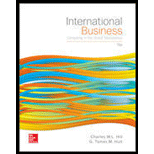
To discuss: The steps to be followed by the exporter to take the effect to export to Country P from City C.
Introduction:
Export refers to the sending of goods from one country to another country and whereas import refers to receiving goods from one country to another country.
Explanation of Solution
The steps to be followed by the exporter to take the effect to export to Country P from City C:
Step: 1
Country P (importers) places an order to Country U (exporters) if they are willing to ship under the letter of credit.
Step: 2
Specification of details on delivery item and price
Step: 3
The importer should apply to any international bank (Bank of city M) to get the letter of credit in the favor of exporter.
Step: 4
The bank will send the letter of credit to the exporter’s bank (City C bank and trust).
Step: 5
The exporter’s bank will advise the exporter to open the letter of credit in its favor.
Step: 6
A common carrier is used by the exporter to importer. This will give the exporter a bill of lading.
Step: 7
The export will give 90 days’ time to export bank (City C bank and trust) which is drawn on bank of City M in agreement with letter of credit and bill of lading.
The exporter will endorse the bill of lading so that the title of goods will be transferred to holder of the document.
Step: 8
Then the exporter bank will present the draft to the importers bank and they will accept the draft and will promise to pay them in 90days
Step: 9
Bank of city M will return the draft to City C bank and trust.
Step: 10
Exporter bank will intimate the export that the draft was accepted by them and payable in 90 days.
Step: 11
Now the export will sell the draft at discount with City C bank and trust and receives the discounted cash value in return.
Step: 12
The importers bank will notify the importer on the arrival of the document and the bank will release the document and the importer can take the possession.
Step: 13
The bank of city M will receive the cash in 90 days so that it will have funds to pay the drafts which are maturing.
Step: 14
In 90 days the final stage is that the City C bank and trust will present for the payment to the bank of City M and the bank will pay.
Want to see more full solutions like this?
Chapter 16 Solutions
International Business: Competing in the Global Marketplace
- What is its net opreting profit after tax?arrow_forwardBeethoven Corp. had net sales of 45,600 and ending accounts receivable of 5,700 for the current period. Its days' sales uncollected equals: (Use 365 days a year.) a. 40.25 days b. 36.17 days c. 45.63 days d. 32.43 days e. 30.47 daysarrow_forwardAQUA SYSTEMS REPORTS THE FOLLOWING SALES OF $150,000; INFORMATION: BEGINNING ASSETS OF $300,000, ENDING ASSETS OF OF $360,000; NET INCOME $9,000. OF THE RETURN ON ASSETS (TO THE NEAREST WHOLE NUMBER) IS: A. 555% B. 30% c. 3% D. 6%arrow_forward
- Which of the following is NOT considered a fixed asset? A. Machinery B. Accounts Receivable C. Building D. Landarrow_forwardStark Corp is in the process of acquiring another business. In light of the acquisition, shareholders are currently re-evaluating the appropriateness of the firm's capital structure (the types of and relative levels of debt and equity). The two proposals being contemplated are detailed below: Proposal 1 Proposal 2 Estimated earnings before interest and taxes (EBIT) $ 450,000 $ 450,000 Long term debt 1,000,000 2,000,000 Market value of equity 1,000,000 500,000 Interest rate on long term debt 10% 10% Tax rate 25% 25% Required Calculate the estimated return on equity (ROE) under the two proposals. (ROE = net income after taxes / market value of equity; net income after taxes = (EBIT - interest on long-term debt) × (1 - tax rate)).arrow_forwardI need guidance with this financial accounting problem using the right financial principles.arrow_forward
- Atlas corporations price earnings ratio??arrow_forwardPlease provide the accurate answer to this general accounting problem using appropriate methods.arrow_forwardThe equity method of accounting is suitable for investments representing what? (1) Less than 20% ownership (2) Between 20% and 50% ownership (3) More than 50% ownership (4) Only for foreign investments answerarrow_forward
- MarketingMarketingISBN:9780357033791Author:Pride, William MPublisher:South Western Educational Publishing
 Practical Management ScienceOperations ManagementISBN:9781337406659Author:WINSTON, Wayne L.Publisher:Cengage,
Practical Management ScienceOperations ManagementISBN:9781337406659Author:WINSTON, Wayne L.Publisher:Cengage, Foundations of Business (MindTap Course List)MarketingISBN:9781337386920Author:William M. Pride, Robert J. Hughes, Jack R. KapoorPublisher:Cengage Learning
Foundations of Business (MindTap Course List)MarketingISBN:9781337386920Author:William M. Pride, Robert J. Hughes, Jack R. KapoorPublisher:Cengage Learning  Foundations of Business - Standalone book (MindTa...MarketingISBN:9781285193946Author:William M. Pride, Robert J. Hughes, Jack R. KapoorPublisher:Cengage Learning
Foundations of Business - Standalone book (MindTa...MarketingISBN:9781285193946Author:William M. Pride, Robert J. Hughes, Jack R. KapoorPublisher:Cengage Learning Purchasing and Supply Chain ManagementOperations ManagementISBN:9781285869681Author:Robert M. Monczka, Robert B. Handfield, Larry C. Giunipero, James L. PattersonPublisher:Cengage Learning
Purchasing and Supply Chain ManagementOperations ManagementISBN:9781285869681Author:Robert M. Monczka, Robert B. Handfield, Larry C. Giunipero, James L. PattersonPublisher:Cengage Learning





